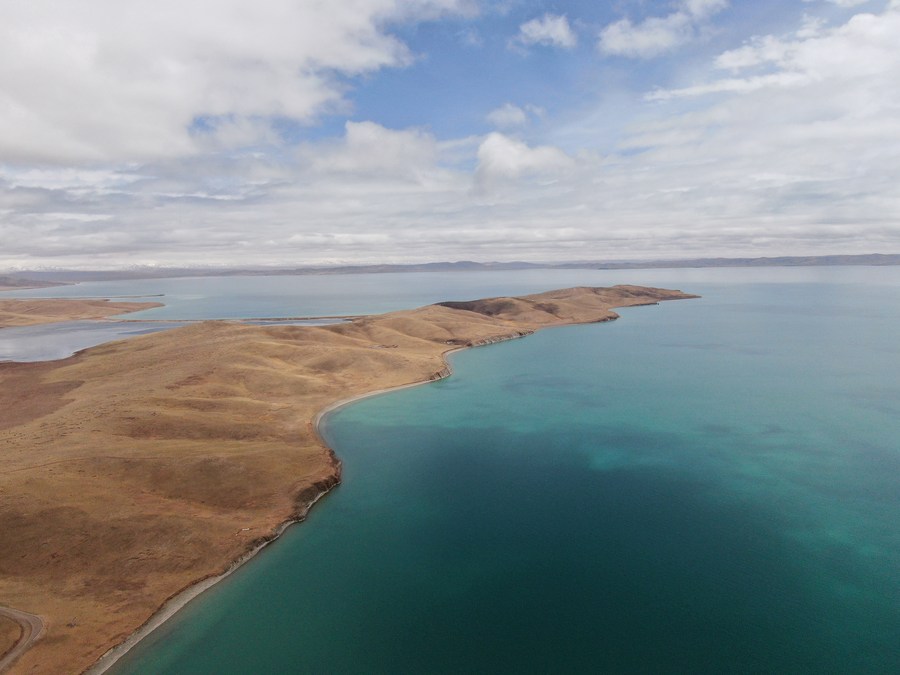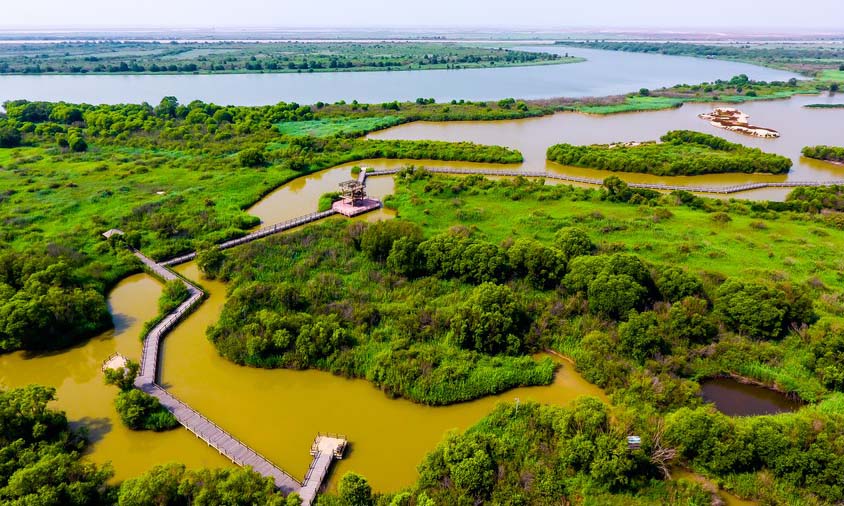Dividends flow from ecological improvement along Yellow River
-- The Yellow River, meandering over 5,000 km from west to east, is called the "mother river" of the Chinese nation, as the river basin has nurtured the Chinese civilization.
-- The ecological protection and high-quality development of the Yellow River basin has been regarded by the Chinese government as a long-term project concerning the very rejuvenation of the nation.
-- The river basin is home to 420 million people, accounting for 30 percent of China's total population. From the plateau headwater to the estuary, increasing biodiversity and people's ever-improving living standards have been observed along with the restoration of the great river.
XINING, June 5 (Xinhua) -- Wearing a fluorescent vest and a red armband, Tibetan ranger Sogsog travels deep into the vast Sanjiangyuan (Three River Source) National Park every month, picking up garbage along his way and checking for any signs of unusual activity on the grassland.
The plateau reserve, known as the headwater region of China's three major rivers -- the Yangtze, Yellow and Lancang, is also the hometown of the 33-year-old Tibetan in Golog Tibetan Autonomous Prefecture, northwest China's Qinghai Province.
The pilot national park, with a total area of 123,100 square km, covers two prefectures, four counties and 53 villages, and harbors more than 70,000 herdsmen.

Aerial photo taken on May 25, 2021 shows a view of Ngoring Lake in the Sanjiangyuan National Park in Golog Tibetan Autonomous Prefecture of northwest China's Qinghai Province. (Xinhua/Li Zhanyi)
Since the pilot project started in 2016, grazing has been banned in 53 million mu (3.5 million hectares) of degraded grassland in the core conservation area of the park.
Sogsog's family ranch is inside the grazing-ban area. He is entitled to government subsidies to compensate him for his lost income from herding his livestock, and another 1,800 yuan (about 281 U.S. dollars) a month from his job as a ranger.
In the Sanjiangyuan National Park, there are 17,000 wildlife rangers like Sogsog who regularly carry out ecological patrols, monitor wild animals and report suspicious poaching activities to the park's administration bureau.
"Now the grass has grown knee high," said Sogsog, after his latest patrol.
He said local herdsmen have never been far from the grassland and livestock. They love to contribute to the park's ecological protection and preserve the luxuriant grassland and lucid water, especially after experiencing terrible grassland degradation, shrinking lakes and rampant rodent damage.
Data from satellite remote sensing show that since the ecological protection of the Sanjiangyuan National Park was launched, the size of Gyaring Lake and Ngoring Lake, two major lakes at the headwater of the Yellow River, has increased by 74.6 square km and 117.4 square km, respectively, and 104 square km of wetland areas have been newly added.
Madoi County in the park's core area, which is dubbed "the county of a thousand lakes," has seen its number of lakes increase from 4,077 to 5,849 since the pilot national park was launched.

Members to maintain ecological security patrol to collect garbage in Madoi County, Golog Tibetan Autonomous Prefecture, northwest China's Qinghai Province, Aug. 19, 2020. (Xinhua/Zhang Long)
The Yellow River, meandering over 5,000 km from west to east, is the second-longest river in China. It runs through nine provinces and autonomous regions in western, central, northern and eastern China.
It is called the "mother river" of the Chinese nation, as the river basin has nurtured the Chinese civilization. The ecological protection and high-quality development of the Yellow River basin has been regarded by the Chinese government as a long-term project concerning the very rejuvenation of the nation.
At the eastern end of the waterway, the environment in the delta deteriorated in the 1980s, due to frequent disruptions in the flow of water from the Yellow River. Many areas had become salinized.
Due to the sparse vegetation and fragile ecological environment, migrating birds such as oriental storks only made brief stopovers on the shore before they traveled to China's warm south.
However, with the protection of the river's headwater taking effect as well as coordinated management measures implemented in the whole river basin, the delta region has been gradually replenished with water from the Yellow River.
In 2020, the river's water feeding into the delta region reached 174 million cubic meters, thrice the annual average in the previous 10 years.

Aerial photo taken on June 23, 2018 shows the wetland of the Yellow River Delta National Nature Reserve in Dongying, east China's Shandong Province. (Xinhua/Guo Xulei)
Wang Andong, a researcher with the Yellow River Delta National Nature Reserve, said 315 oriental storks were born in the reserve in 2020.
Now, more than 370 bird species have been observed in the reserve, including 24 species under national first-class protection such as red-crowned cranes and oriental white storks, and 64 species of second-class protected birds such as big swans and grey cranes.
"Birds know best where the environment is good," said Li Kuanduan, secretary of the Dongying municipal committee of the Communist Party of China.
He said the city of Dongying in the Yellow River delta has learned the importance of the ecological environment. The city has initiated a spate of wetland restoration programs so as to increase the total wetland area to 4,567 square km, accounting for about one-quarter of the wetland area in east China's Shandong Province.
As part of efforts to promote differentiated measures taken by provincial-level regions along the Yellow River, disciplinary inspection teams have been dispatched to strengthen coordination and oversee the fulfillment of key responsibilities.
The river basin is home to 420 million people, accounting for 30 percent of China's total population. From the plateau headwater to the estuary, increasing biodiversity and people's ever-improving living standards have been observed along with the restoration of the great river.
For this year's World Environment Day, which falls on Saturday, China's theme is harmonious coexistence between people and nature. It is also the theme of ecological dialogue between the western and eastern ends of the Yellow River.
Photos
Related Stories
- China's Yellow River water quality improved in past five years
- Interview: China's poverty alleviation success demonstrates CPC's strong leadership -- Ghanaian party leader
- Chinese export insurance company reports steady business growth
- China's futures market reports robust profit growth
- China expected to see robust tourism in upcoming holiday: report
Copyright © 2021 People's Daily Online. All Rights Reserved.










